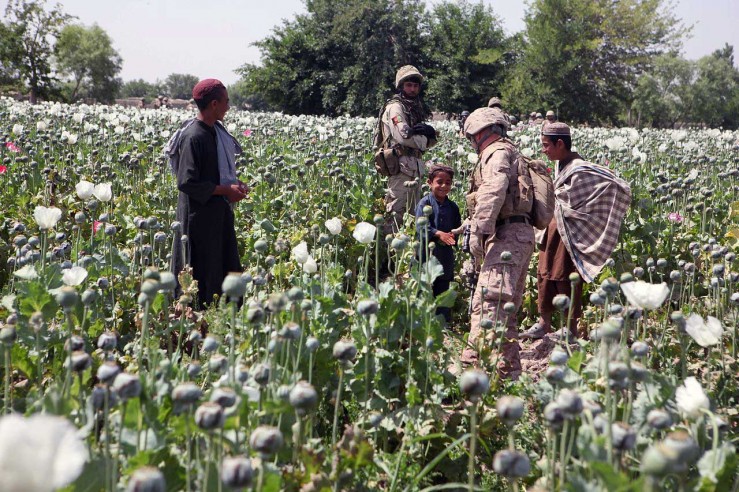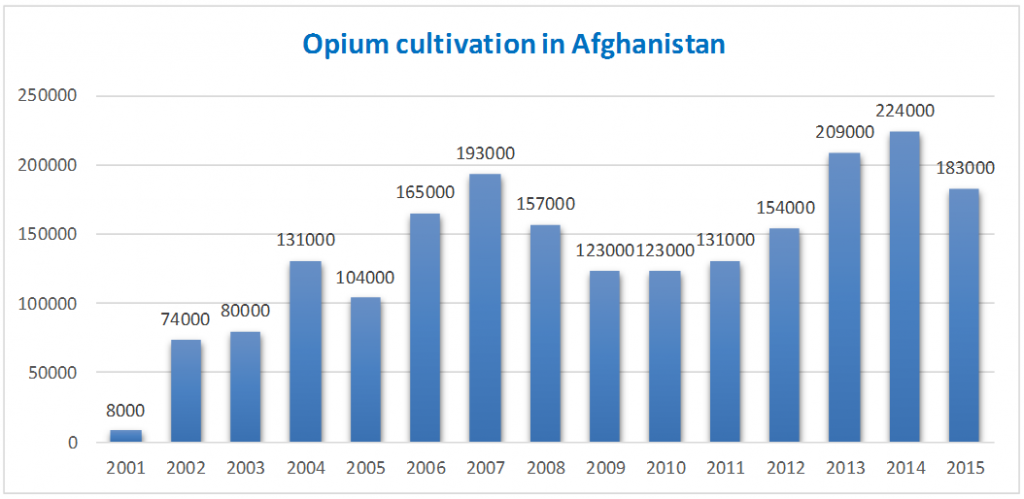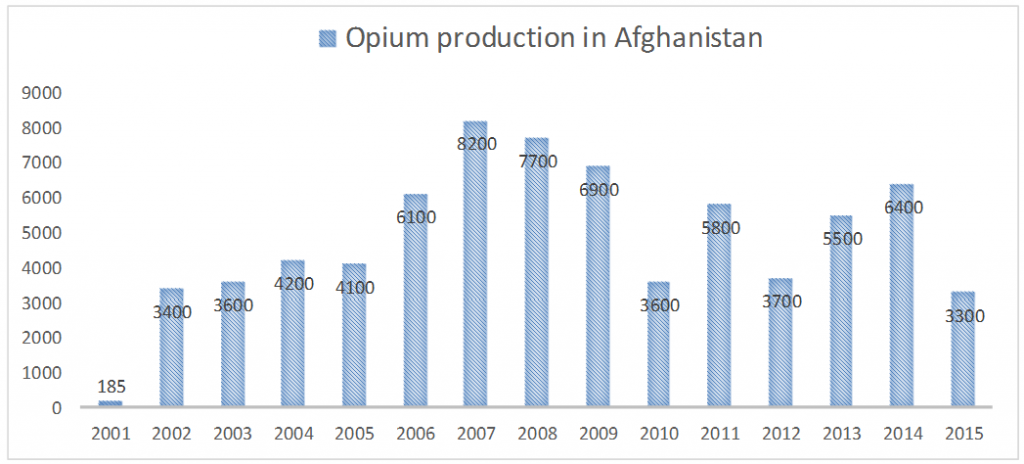Afghanistan: failure in fight against narcotics
A joint report of the Afghan government and the United Nations Office on Drugs and Crime (UNODC) shows that in 2016, poppy cultivation has increased 10% and opium production has increased 43% and once again Afghanistan is one of the major opium producers in the world.
After the publication of this report, Wolesi Jirga (the Lower House of the Afghan Parliament) summoned Ministers of Counter Narcotics, Public Health and Interior Affairs and the parliament members asked questions about reasons behind the increase in poppy cultivation and the number of addicted people in the country. [1]
Although, in some occasions, the Afghan government talks about achievements in fight against narcotics such as arresting some drug smugglers and destroying lands under poppy cultivation. But since the cultivation, production and smuggling of opium have increased; the Afghan government accepts that it has failed in its struggle against narcotics in this year.
Although, the drug issue is a global challenge and all the countries in the world are affected by the negative aspects of this phenomenon. Statistics show that the number of addicts is over 250 million worldwide. But Afghanistan is one of the countries that have severely suffered by this phenomenon. On the one hand, opium cultivation and production undermines Afghanistan’s prestige and on the other hand, around 3.5 million Afghans, somehow, use opium, 1.5 million of which are in critical condition.
The increasing statistics of drugs in 2001
The official statistics of official institutions, particularly UNODC, show that there were 8000 hectares of lands under poppy cultivation in 2001 (the last year of the Taliban regime) in Afghanistan; but after overthrow of the Taliban regime poppy cultivation increased annually.
In 2007, 193000 hectares of lands in Afghanistan was under poppy cultivation. Although in 2008 and 2010 poppy cultivation decreased in the country but later it increased again and reached its highest level in 2014 (224000 hectares) thus poppy cultivation in 2013 and 2014 reached new heights (Chart-1). A 19% decrease in poppy cultivation in 2015, compared to 2014, was due to bad weather and not the policies of the Afghan government[2] (Chart-1).
Chart-1: opium cultivation in Afghanistan (2001-2015) (hectares)
Source: UNODC/MCN
Opium production also increased in post-2001 years. In 2001, opium production was 185 tons; but in 2007, 8200 tons of opium was produced in Afghanistan. After 2010, lands under poppy cultivation increased but foreign troops amplified eradication of poppy fields by pouring anti-poppy materials from air and, as a result, in 2012, the opium production decreased to 3700 tons. Inclined production of opium in 2012 urged farmers to bring more lands under poppy cultivation; thus, opium production in 2013 and 2014 reached respectively to 5500 tons and 6400 tons (chart-2).
Chart-2: Opium production in Afghanistan (2001-2015) (tons)
Source: UNODC/MCN
Increase in the narcotics in 2016
Compared to 2015, opium poppy cultivation considerably increased in 2016. In 2016, there was 201000 hectares of lands under poppy cultivation in Afghanistan while in 2015 this number was 183000 hectares, therefore, in 2016, poppy cultivation marks a 43% increase.
According to the joint annual report of the Afghan Ministry of Counter Narcotics (MCN) and UNODC, opium production in 2015 was 3300 tons in Afghanistan; but the recent report of UNODC and MCN shows that 4800 tons of opium was produced in 2016 which marks a 10% increase[3].
The main reason behind increase in poppy cultivation in 2016 was insecurity in the country. 80273 hectares of land (which is 40% of lands under poppy cultivation in all over the country) was under opium cultivation in Helmand- one of the most insecure provinces of the country. In Northern provinces including Jawzjan province, which were poppy-free, insecurity has led these provinces to once again start cultivation of opium. On the other hand, good yields and weather was also one of the reasons behind increase in opium production in this year.
International mafia and Afghan drug
Drug trade, after oil and arms trade, constitutes the largest figure in international trade.
When the United States and its allies entered in Afghanistan in 2001, they said that “terrorism” and drug trafficking are linked to each other and in order to eliminate “terrorism”; drug production must be stopped. But the question is why opium production in Afghanistan has been increasing since 2001 so far?
Although, increase in opium cultivation and smuggling, in the past one decade, do not have one sole reason; but a collection of internal and foreign factors are behind it; but the most important factor is lack of a firm internal and international willingness in struggle against narcotics. Another factor behind it is the role of people who have connections with drug mafias.
On the other hand, hundreds of metric tons of heroin is being exported to other regions like Europe by land transit, which is impossible without assistance of the officials with the mafia in the countries from which the heroin are being smuggled.
According to the statistics of UNODC, from the $70bn incomes of drugs in Afghanistan, only $2bn went to farmers and $66bn remaining money went to drug smugglers and mafia inside and outside Afghanistan. [4]
The Afghan government and its struggle against narcotics
When forming a new government after the fall of the Taliban regime in Bonn Conference, a Ministry was formed to counter narcotics. In 1393, former Afghan President Hamid Karzai announced that the fight against drugs is a priority for the Afghan government and its cultivation, production and trafficking is banned.
During the past decade, several institutions were involved in the fight against narcotics in Afghanistan, but still about 90 percent of the world’s opium is produced in Afghanistan. UNODC, the counter narcotics department of Ministry of Interior, Ministry of Public Health and Ministry of Agriculture are institutions that are involved in fight against narcotics in Afghanistan and Ministry of Counter Narcotics is responsible to lead and coordinate the relevant activities.
Despite the high costs in all aspects of the fight against drugs (to prevent poppy cultivation and opium production, to combat drug trafficking, to prevent drug addiction and to treat drug addicts), in this regard, the Afghan government has not been successful. According to the Special Inspector General for Afghanistan’s Reconstruction (SIGAR), in the past fourteen years, the United States have spent $7,6bn in its counter narcotics struggle in Afghanistan. [5] But in countries such as Afghanistan, which are being governed by “failed states”, spending money in the fight against narcotics can only help corrupt government officials and farmers never benefit from it.
After the formation of the national unity government, it did not focus on the fight against narcotics and has been rather involved in internal disputes and other challenges such as insecurity in the country. The international community and the Afghan government have claimed that the increase in drug cultivation and trafficking is directly related with insecurity and war in the country. Undoubtedly, this is effective in expanding and increasing drug cultivation and trafficking in the country, but unfortunately, it is used as a cover for the failures in the fight against narcotics.
Expansion of opium cultivation in Afghanistan is related to many factors, but the chief factors among them can be as such:
- Prolonged war and insecurity in the country;
- The absence of a strong and people backed central government;
- Existence of drug mafia, including domestic, regional and international mafia;
- Drug demands, especially in Western countries;
- Suitable soil and climate for growing poppy.
Many analysts believe that the Afghan government lacks serious willingness in the fight against narcotics, but besides that, the war and insecurity in the country, lack of law enforcement, the armed oppositions’ involvement in the cultivation and production of drugs in insecure provinces and corruption are other factors that have challenged the fight against drugs. Therefore, a competent government with complete dominance in all over the country could be the solution to this problem.
The end
[1] Read this report of BBC for details: http://www.bbc.com/persian/afghanistan-37753541
[2] UNODC, Afghanistan Opium Survey 2015, see it online: https://www.unodc.org/documents/crop-monitoring/Afghanistan/Afg_Executive_summary_2015_final.pdf
[3] UNODC, Afghan opium production up 43 per cent: Survey, 23 October 2016, see it online:
[4] For further information: Weekly Analysis Issue number 74, >Afghanistan: problems in struggling against narcotics<, see it online:
https://csrskabul.com/en/blog/weekly-analysis-issue-number-74-june-7-14-2014/
[5] SIGAR, Special Report: Poppy Cultivation in Afghanistan, see it online: https://www.sigar.mil/pdf/Special%20Projects/SIGAR-15-10-SP.pdf



